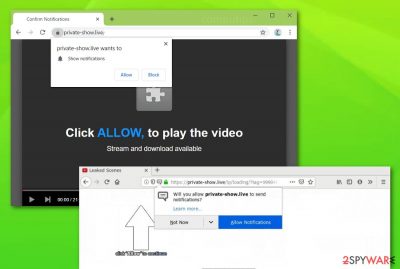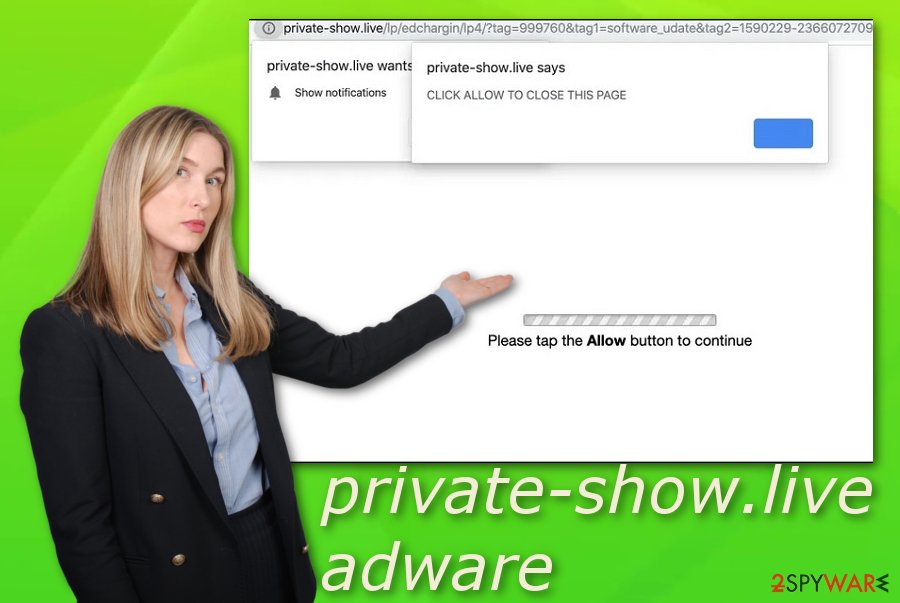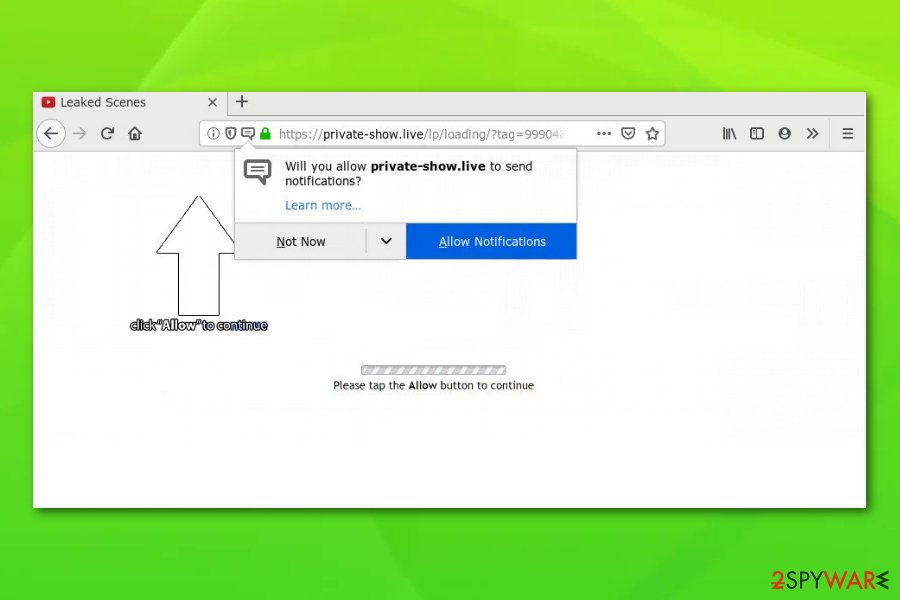Private-show.live (Improved Instructions) - Virus Removal Guide
Private-show.live Removal Guide
What is Private-show.live?
Private-show.live – adware that asks for human verification or watching a video by clicking the “Allow” button

Private-show.live is a potentially unwanted program that tries to attract as many subscribers as possible. The adware convinces users to click on the “Allow” button to give permission to the incoming notifications and earn from the pay-per-click[1] method. Developers might load you with convenient-looking deals which, however, will be just a way to swindle your money or private data. Regularly, adware is not malware but you can call this program Private-show.live virus due to its unexpected installation process and the bogus activities it completes under the user's own will.
| Name | Private-show.live |
|---|---|
| Type | Potentially unwanted program |
| Sub-type | Adware application |
| Goal | To collect income from the pay-per-click technique whenever the user clicks on an advertisement |
| Activities | This rogue app is responsible for intrusive advertising/redirecting during browser sessions, changing the homepage and new tab URL, collecting browsing information about users |
| Removal | Use reliable software or step-by-step guidelines to eliminate the adware program from your computer and browser apps |
| Repair | If the adware virus has compromised some files of yours, try repairing them with FortectIntego |
Private-show.live can start pushing unwanted ads to your web browser straight after the hijacking the app. In addition, you might see questionable modifications in the browser's homepage and new tab URL that have been converted by the adware application during its active period.
Besides these changes, Private Show Live can add suspicious extensions and plug-ins to your browser settings which also need to be eliminated if you want to terminate the adware properly. These components are the ones responsible for frequent advertising and redirecting that you will supposedly start receiving constantly.
In some cases, Private-show.live pop-ups might appear when visiting bogus locations. You might be able to stop the ad flow by installing Adblock Plus[2] or by eliminating the suspicious domain from the Notifications list if it had appeared there. You can complete the following action by carrying out the below-given steps:
- Go to the web browser that has been showing you ads.
- Find the three dots on your upper right.
- Open the menu and go to Settings > Advanced.
- Find Notifications and search for Private-show.live in the list.
- Click the remove/disable feature to eliminate the suspicious URL from the menu.

Keep in mind that Private Show Live is capable of performing more than one action at a time and could go even to multiple processes per session. Such tasks might start overusing your computer's energy resources. This means that the CPU power can rise over 90% and lead to overheating.
Continuously, Private-show.live offers and deals might require you to enter personal or credential information in order to receive a particular reward or prize. Do not fill any surveys or fake reward claims as you will not win any promised mobile phone or another product/service. The developers are just looking for more ways to benefit from you.
However, the most popular way to receive income from you is to promote the cost-per-click technique. Private-show.live will provide you with pop-up ads and the more notifications you press, the more the income falls into the developers' pockets. Keep in mind that such process is beneficial only for the creators but not the user himself.
Private-show.live removal is the best thing to do to avoid suspicious redirects and advertisements appearing on your computer screen. You can try to get rid of the potentially unwanted program with the help of antimalware software or by applying the step-by-step guidelines that are added to the end of this article.
After you remove Private-show.live from your computer system, you should check for possible file corruption. If you find some components that might have been compromised by adware, you can try repairing them with software such as FortectIntego.

Adware hiding places can differ
According to experts from Virusai.lt,[3] adware programs are usually spread via “software bundling”. However, you can find such free program packages filled with PUPs on third-party sources such as download.com, softonic.com, soft32.com, and cnet.com.
Continuously, adware-related apps can be distributed via fake software updates, especially, flash player ones. Some developers release messages that force users to believe that they are lacking some kind of program update and once he/she presses the “update” button, the fake update launches the adware installation.
Other adware distribution sources might include infectious hyperlinks and advertisements, software cracks, outdated programs, etc. The best way to protect yourself from secret PUP infiltration is to install reliable antivirus software and pay close attention to every move you make on the Internet sphere.
Additionally, the chosen installation mode matters. If you have opted for the Quick/Recommended configuration, there is a high risk of receiving an adware infection on your computer system. Go for the Custom/Advanced mode where you will be able to take full control of your incoming downloads and opt-out all rogue components.
Private-show.live virus removal tips
Private-show.live virus will supposedly decrease the stability and efficiency of your computing and browsing work. In order to bring your machine back to its previous state and ensure full security, you need to terminate the adware program.
Remove Private-show.live from your Windows/macOS computer and web browsers such as Google Chrome, Mozilla Firefox, Internet Explorer, Microsoft Edge, and Safari. You can accomplish such a task with the help of reliable antimalware software or by using step-by-step guidelines that are added to the end of this article.
After Private-show.live removal, you can try using system repair software if the adware has compromised some files or entries on your computer system as it might help you to restore the components back to their previous states. Also, be aware that the PUP might plant bogus products all over the machine which also need to be terminated in order to succeed in full virus elimination, otherwise, the adware might return within the next computer boot process.
You may remove virus damage with a help of FortectIntego. SpyHunter 5Combo Cleaner and Malwarebytes are recommended to detect potentially unwanted programs and viruses with all their files and registry entries that are related to them.
Getting rid of Private-show.live. Follow these steps
Uninstall from Windows
To eliminate the adware from Windows, employ the following steps
Instructions for Windows 10/8 machines:
- Enter Control Panel into Windows search box and hit Enter or click on the search result.
- Under Programs, select Uninstall a program.

- From the list, find the entry of the suspicious program.
- Right-click on the application and select Uninstall.
- If User Account Control shows up, click Yes.
- Wait till uninstallation process is complete and click OK.

If you are Windows 7/XP user, proceed with the following instructions:
- Click on Windows Start > Control Panel located on the right pane (if you are Windows XP user, click on Add/Remove Programs).
- In Control Panel, select Programs > Uninstall a program.

- Pick the unwanted application by clicking on it once.
- At the top, click Uninstall/Change.
- In the confirmation prompt, pick Yes.
- Click OK once the removal process is finished.
Delete from macOS
Remove items from Applications folder:
- From the menu bar, select Go > Applications.
- In the Applications folder, look for all related entries.
- Click on the app and drag it to Trash (or right-click and pick Move to Trash)

To fully remove an unwanted app, you need to access Application Support, LaunchAgents, and LaunchDaemons folders and delete relevant files:
- Select Go > Go to Folder.
- Enter /Library/Application Support and click Go or press Enter.
- In the Application Support folder, look for any dubious entries and then delete them.
- Now enter /Library/LaunchAgents and /Library/LaunchDaemons folders the same way and terminate all the related .plist files.

Remove from Microsoft Edge
Delete unwanted extensions from MS Edge:
- Select Menu (three horizontal dots at the top-right of the browser window) and pick Extensions.
- From the list, pick the extension and click on the Gear icon.
- Click on Uninstall at the bottom.

Clear cookies and other browser data:
- Click on the Menu (three horizontal dots at the top-right of the browser window) and select Privacy & security.
- Under Clear browsing data, pick Choose what to clear.
- Select everything (apart from passwords, although you might want to include Media licenses as well, if applicable) and click on Clear.

Restore new tab and homepage settings:
- Click the menu icon and choose Settings.
- Then find On startup section.
- Click Disable if you found any suspicious domain.
Reset MS Edge if the above steps did not work:
- Press on Ctrl + Shift + Esc to open Task Manager.
- Click on More details arrow at the bottom of the window.
- Select Details tab.
- Now scroll down and locate every entry with Microsoft Edge name in it. Right-click on each of them and select End Task to stop MS Edge from running.

If this solution failed to help you, you need to use an advanced Edge reset method. Note that you need to backup your data before proceeding.
- Find the following folder on your computer: C:\\Users\\%username%\\AppData\\Local\\Packages\\Microsoft.MicrosoftEdge_8wekyb3d8bbwe.
- Press Ctrl + A on your keyboard to select all folders.
- Right-click on them and pick Delete

- Now right-click on the Start button and pick Windows PowerShell (Admin).
- When the new window opens, copy and paste the following command, and then press Enter:
Get-AppXPackage -AllUsers -Name Microsoft.MicrosoftEdge | Foreach {Add-AppxPackage -DisableDevelopmentMode -Register “$($_.InstallLocation)\\AppXManifest.xml” -Verbose

Instructions for Chromium-based Edge
Delete extensions from MS Edge (Chromium):
- Open Edge and click select Settings > Extensions.
- Delete unwanted extensions by clicking Remove.

Clear cache and site data:
- Click on Menu and go to Settings.
- Select Privacy, search and services.
- Under Clear browsing data, pick Choose what to clear.
- Under Time range, pick All time.
- Select Clear now.

Reset Chromium-based MS Edge:
- Click on Menu and select Settings.
- On the left side, pick Reset settings.
- Select Restore settings to their default values.
- Confirm with Reset.

Remove from Mozilla Firefox (FF)
To get rid of suspicious content from Firefox, try out these guidelines
Remove dangerous extensions:
- Open Mozilla Firefox browser and click on the Menu (three horizontal lines at the top-right of the window).
- Select Add-ons.
- In here, select unwanted plugin and click Remove.

Reset the homepage:
- Click three horizontal lines at the top right corner to open the menu.
- Choose Options.
- Under Home options, enter your preferred site that will open every time you newly open the Mozilla Firefox.
Clear cookies and site data:
- Click Menu and pick Settings.
- Go to Privacy & Security section.
- Scroll down to locate Cookies and Site Data.
- Click on Clear Data…
- Select Cookies and Site Data, as well as Cached Web Content and press Clear.

Reset Mozilla Firefox
If clearing the browser as explained above did not help, reset Mozilla Firefox:
- Open Mozilla Firefox browser and click the Menu.
- Go to Help and then choose Troubleshooting Information.

- Under Give Firefox a tune up section, click on Refresh Firefox…
- Once the pop-up shows up, confirm the action by pressing on Refresh Firefox.

Remove from Google Chrome
To clean Google Chrome from unwanted objects, follow these steps
Delete malicious extensions from Google Chrome:
- Open Google Chrome, click on the Menu (three vertical dots at the top-right corner) and select More tools > Extensions.
- In the newly opened window, you will see all the installed extensions. Uninstall all the suspicious plugins that might be related to the unwanted program by clicking Remove.

Clear cache and web data from Chrome:
- Click on Menu and pick Settings.
- Under Privacy and security, select Clear browsing data.
- Select Browsing history, Cookies and other site data, as well as Cached images and files.
- Click Clear data.

Change your homepage:
- Click menu and choose Settings.
- Look for a suspicious site in the On startup section.
- Click on Open a specific or set of pages and click on three dots to find the Remove option.
Reset Google Chrome:
If the previous methods did not help you, reset Google Chrome to eliminate all the unwanted components:
- Click on Menu and select Settings.
- In the Settings, scroll down and click Advanced.
- Scroll down and locate Reset and clean up section.
- Now click Restore settings to their original defaults.
- Confirm with Reset settings.

Delete from Safari
Remove unwanted extensions from Safari:
- Click Safari > Preferences…
- In the new window, pick Extensions.
- Select the unwanted extension and select Uninstall.

Clear cookies and other website data from Safari:
- Click Safari > Clear History…
- From the drop-down menu under Clear, pick all history.
- Confirm with Clear History.

Reset Safari if the above-mentioned steps did not help you:
- Click Safari > Preferences…
- Go to Advanced tab.
- Tick the Show Develop menu in menu bar.
- From the menu bar, click Develop, and then select Empty Caches.

After uninstalling this potentially unwanted program (PUP) and fixing each of your web browsers, we recommend you to scan your PC system with a reputable anti-spyware. This will help you to get rid of Private-show.live registry traces and will also identify related parasites or possible malware infections on your computer. For that you can use our top-rated malware remover: FortectIntego, SpyHunter 5Combo Cleaner or Malwarebytes.
How to prevent from getting adware
Do not let government spy on you
The government has many issues in regards to tracking users' data and spying on citizens, so you should take this into consideration and learn more about shady information gathering practices. Avoid any unwanted government tracking or spying by going totally anonymous on the internet.
You can choose a different location when you go online and access any material you want without particular content restrictions. You can easily enjoy internet connection without any risks of being hacked by using Private Internet Access VPN.
Control the information that can be accessed by government any other unwanted party and surf online without being spied on. Even if you are not involved in illegal activities or trust your selection of services, platforms, be suspicious for your own security and take precautionary measures by using the VPN service.
Backup files for the later use, in case of the malware attack
Computer users can suffer from data losses due to cyber infections or their own faulty doings. Ransomware can encrypt and hold files hostage, while unforeseen power cuts might cause a loss of important documents. If you have proper up-to-date backups, you can easily recover after such an incident and get back to work. It is also equally important to update backups on a regular basis so that the newest information remains intact – you can set this process to be performed automatically.
When you have the previous version of every important document or project you can avoid frustration and breakdowns. It comes in handy when malware strikes out of nowhere. Use Data Recovery Pro for the data restoration process.
- ^ What is pay per click?. Quora.com. Relevant questions and answers.
- ^ Adblock Plus. Wikipedia. The free encyclopedia.
- ^ Virusai.lt. Virusai. Security and spyware news.























